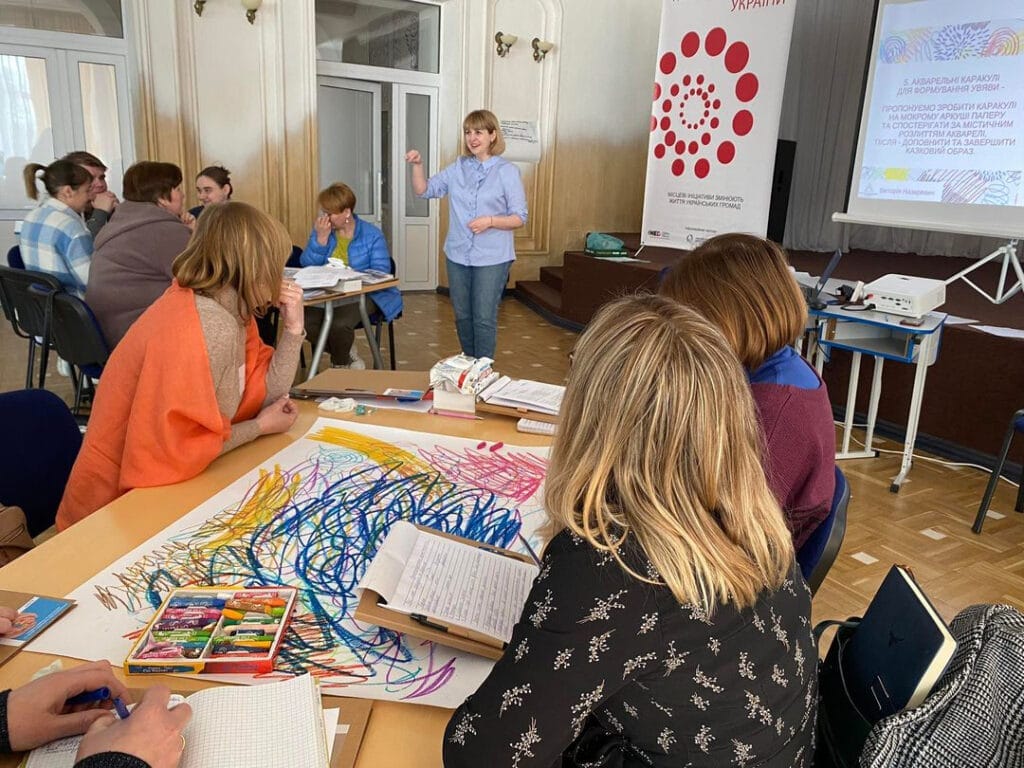News > Blog
Ukraine’s Resilience Strengthened by Grassroots Psychosocial Support and Civic Partnerships
Published 12/14/2023 by Global Communities

By Tania Dudnyk
Chernihiv oblast has been one of the regions most severely affected by the ongoing Russian invasion of Ukraine. When it was under Russian occupation during the first five weeks of the war, residents – including children – were forced to spend long hours and days in shelters to protect themselves from heavy gunfire and shelling.
That experience, coupled with displacement, loss of loved ones, chronic exposure to violence, lack of stability and a host of other adversities, had a devastating impact on the mental health and well-being of civilians.


In light of these issues, Global Communities is working through local civil society organizations (CSOs) in remote communities of Ukraine to strengthen and scale up psychosocial support services as part of the Community-Led Emergency Action and Response (CLEAR) program. With funding from the United States Agency for International Development’s Bureau for Humanitarian Assistance (USAID/BHA), CLEAR has been able to reach those in need who are overlooked by large humanitarian projects. The project’s approach is driven by the understanding that local organizations are best positioned to understand and meet the unique needs of the communities they serve with the right support and technical assistance.
One example of a successful CLEAR partnership in action is a project led by Civic Initiatives of Ukraine, a local CSO in the Chernihiv region. Even before Russia’s full-scale invasion, the region did not have enough qualified professionals to meet the growing need for psychological support among residents. Over the years, the positions of school psychologists were reduced. And in rural areas, they did not exist at all. After the first explosions in the Chernihiv region in February 2022, psychologists who had worked in relatively large settlements left Ukraine or moved to other regions as internally displaced people.
Nelia Lavrynenko had experience working in charitable camps for children from the eastern part of Ukraine, where the first stage of the war started in 2014. After the liberation of the Chernihiv region, she quickly understood the critical need for psychosocial support for people living in these territories. Her idea was to train schoolteachers to provide psychological first aid for children using art therapy.
Under Nelia’s leadership – and with support from the CLEAR program via Civic Initiatives of Ukraine – 45 teachers and school psychologists from three communities in the region underwent training on using art therapy with children. The project purposefully selected people willing to work as volunteers.

“From my long-term experience in a public area, those who sincerely consider this job as needed for themselves and other people are ready to work as volunteers,” Nelia said. “If we pay people from the very beginning, we will have plenty of those interested, but in some time, the program and financing will end. And what then?”
During the training, the school workers learned not only theory but also practiced using clay, playdough, strings and sand as resources for therapy. With funding from USAID/BHA, Civic Initiatives of Ukraine provided all the necessary materials for these activities and supervising support. At the final stage of the training, newly educated professionals worked out their knowledge in groups. Then, they started the practice in their communities. After several classes with children, parents who were encouraged by the results asked the art therapists if they could provide the same classes for adults.
“These classes are a completely new experience for me,” said Nadiia, a Ukrainian Language teacher who received training under the CLEAR program on how to apply art therapy methods with children. “I feel like another person, so inspired by what I do together with these children, as if I am healing on my own.”
According to Civic Initiatives of Ukraine, art therapists can recognize if art therapy is enough for a child or if specialized war trauma therapy is needed as well. Usually, those children who are not traumatized deeply show signs of improvement after 10 classes. If after 10-15 art classes, no changes have been observed in a child’s mental state, art therapists recommend sessions with trauma professionals. Even so, only one child psychiatrist is available in the entire region.
After Nelia’s project under the CLEAR program showed successful results, Chernihiv regional state authorities initiated a meeting with all organizations that work on psychosocial support in their communities. Now, they are working on mapping areas where psychosocial support is available and where additional resources are needed.
The art therapists who underwent training via Civic Initiatives of Ukraine have already been thinking about how to move forward after support from the CLEAR program ends.
“We focus them on the fact that they have already had a community and experience. They could organize and start their own projects,” Nelia said. “These people are extremely sincere in their worries and care about people in their communities. In half a year, they completed everything that we had planned for them for a year. Now they are eagerly interested in further development.”
Meanwhile, under the CLEAR program, art therapists also had the opportunity to attend training on burnout prevention to gain knowledge on how to fulfill their own needs while helping others.




